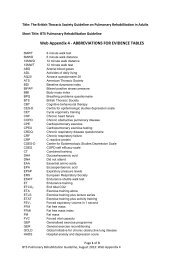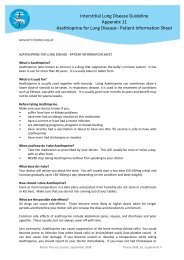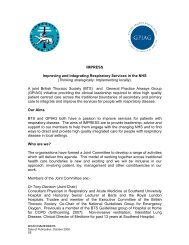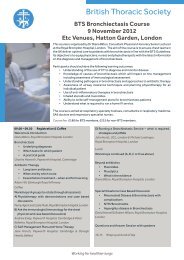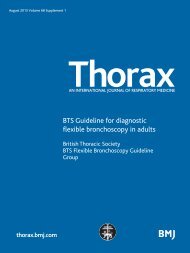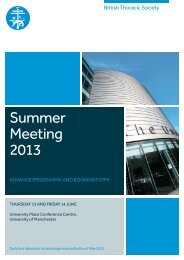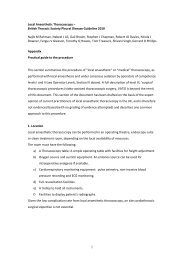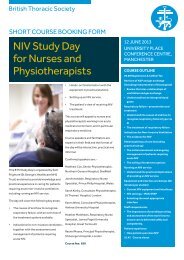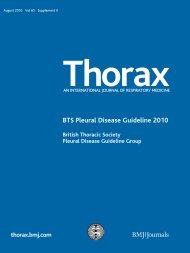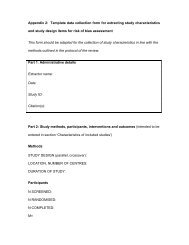Guidelines for the management of community ... - Brit Thoracic
Guidelines for the management of community ... - Brit Thoracic
Guidelines for the management of community ... - Brit Thoracic
You also want an ePaper? Increase the reach of your titles
YUMPU automatically turns print PDFs into web optimized ePapers that Google loves.
BTS guidelines<br />
Appendix 3<br />
Types <strong>of</strong> study and levels <strong>of</strong> evidence used to illuminate specific clinical questions<br />
Type <strong>of</strong> clinical question Evidence level Brief definition Types <strong>of</strong> study providing this level <strong>of</strong> evidence<br />
Treatment Ia A good recent systematic review Systematic review <strong>of</strong> randomised trials<br />
Ib A rigorous study designed to answer <strong>the</strong> question A rigorous randomised trial comparing T with best alternative<br />
Is <strong>the</strong>rapy T effective? II One or more prospective clinical studies A cohort study or faulty randomised trial<br />
III One or more retrospective clinical studies A case-control study<br />
IVa Formal expert consensus Delphi study <strong>of</strong> expert practice<br />
IVb O<strong>the</strong>r in<strong>for</strong>mation Study <strong>of</strong> pharmacology <strong>of</strong> T<br />
Aetiology or harm Ia A good recent systematic review Systematic review <strong>of</strong> cohort studies<br />
Does A cause disease D? Ib A rigorous study designed to answer <strong>the</strong> question A large well-designed cohort study<br />
Does drug D cause side effect S? II One or more prospective clinical studies A faulty cohort study<br />
III One or more retrospective clinical studies A case-control study<br />
IVa Formal expert consensus Delphi study <strong>of</strong> expert opinion<br />
IVb O<strong>the</strong>r in<strong>for</strong>mation Study <strong>of</strong> pathophysiology <strong>of</strong> D<br />
Diagnosis or prognosis Ia A good recent systematic review Systematic review <strong>of</strong> blind comparisons <strong>of</strong> T with gold standard<br />
Is T an accurate test <strong>for</strong> diagnosis<br />
<strong>of</strong> D?<br />
Is finding F an accurate predictor<br />
<strong>of</strong> event E?<br />
Does severity measure M<br />
accurately predict event E?<br />
Ib A rigorous study designed to answer <strong>the</strong> question Blind prospective comparison <strong>of</strong> T, F or M with gold standard <strong>for</strong> D or E<br />
(eg, response to specific <strong>the</strong>rapy) with multivariate analysis<br />
II One or more prospective clinical studies Analysis <strong>of</strong> prospective test results in patients enrolled in a randomised<br />
clinical trial <strong>of</strong> <strong>the</strong>rapy <strong>for</strong> varying stages <strong>of</strong> D. Prospective validation<br />
study with univariate analysis<br />
III One or more retrospective clinical studies Retrospective study <strong>of</strong> test results or findings in a database <strong>of</strong> patients<br />
with univariate or multivariate analysis<br />
IVa Formal expert consensus Delphi study <strong>of</strong> expert opinion about T<br />
IVb O<strong>the</strong>r in<strong>for</strong>mation Study <strong>of</strong> pathophysiology <strong>of</strong> D<br />
Public health, health policy Ia Economic and policy analysis based on good<br />
recent systematic reviews<br />
Is policy P cost effective in <strong>the</strong><br />
NHS?<br />
Ib<br />
Economic and policy analysis based on a rigorous<br />
study designed to answer <strong>the</strong> question<br />
Economic and policy analysis with modelling and sensitivity analysis<br />
using data from systematic reviews <strong>of</strong> effectiveness and <strong>of</strong> cost studies<br />
in <strong>the</strong> same routine clinical settings<br />
Economic and policy analysis with modelling and sensitivity analysis<br />
using data from a randomised clinical trial <strong>of</strong> effectiveness and a cost<br />
study in <strong>the</strong> same routine clinical setting<br />
Economic and policy analysis with modelling and sensitivity analysis<br />
using o<strong>the</strong>r prospective data in various settings<br />
Economic and policy analysis with modelling and sensitivity analysis<br />
using retrospective data<br />
II<br />
Economic and policy analysis based on one or<br />
more prospective clinical studies<br />
III<br />
Economic and policy analysis based on one or<br />
more retrospective clinical studies<br />
IVa Formal expert consensus Delphi study <strong>of</strong> national expert opinion about P<br />
IVb O<strong>the</strong>r in<strong>for</strong>mation Local opinion about P<br />
Appendix 4<br />
Generic levels <strong>of</strong> evidence and guideline statement grades, appropriate across all types <strong>of</strong> clinical questions<br />
Evidence<br />
level Definition Example <strong>of</strong> study providing this level <strong>of</strong> evidence <strong>for</strong> a <strong>the</strong>rapy question<br />
Ia<br />
Ib<br />
A good recent systematic review <strong>of</strong> studies designed to<br />
answer <strong>the</strong> question <strong>of</strong> interest<br />
One or more rigorous studies designed to answer <strong>the</strong><br />
question, but not <strong>for</strong>mally combined<br />
One or more prospective clinical studies which illuminate, but<br />
do not rigorously answer, <strong>the</strong> question<br />
One or more retrospective clinical studies which illuminate<br />
but do not rigorously answer <strong>the</strong> question<br />
Cochrane systematic review <strong>of</strong> randomised controlled trials studying <strong>the</strong><br />
effectiveness <strong>of</strong> flu vaccines<br />
Randomised controlled trial <strong>of</strong> effectiveness <strong>of</strong> a flu vaccine<br />
II*<br />
Prospective cohort study comparing pneumonia rates in patients who are and B+<br />
are not vaccinated against flu; non-randomised controlled trial<br />
III{<br />
Audit or retrospective case control study, comparing flu vaccination history in B2<br />
patients who did and did not present with pneumonia<br />
IVa{ Formal combination <strong>of</strong> expert views Delphi study <strong>of</strong> UK expert recommendations <strong>for</strong> flu vaccination C<br />
IVb O<strong>the</strong>r in<strong>for</strong>mation Expert opinion, in<strong>for</strong>mal consensus; in vitro or in vivo studies on related topics D<br />
Guideline<br />
statement grade<br />
*Hard to differentiate Agency <strong>for</strong> Health Care Policy and Research’s ‘‘well designed controlled study without randomisation’’ (level IIa) from ‘‘o<strong>the</strong>r type <strong>of</strong> well-designed<br />
experimental study’’ (level IIb).<br />
{Major criterion is retrospective versus prospective data collection, since non-experimental designs are better suited than even randomised clinical trials <strong>for</strong> answering certain<br />
questions.<br />
{Distinguish <strong>for</strong>mal consensus from in<strong>for</strong>mal consensus methods according to <strong>the</strong> Health Technology Assessment 1998 systematic review.<br />
A+<br />
A2<br />
Thorax 2009;64(Suppl III):iii1–iii55. doi:10.1136/thx.2009.121434<br />
iii55



